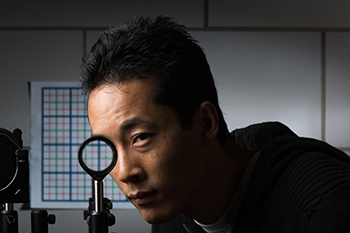
University of Rochester Ph.D. student Joseph Choi is pictured with a multidirectional "perfect paraxial" cloak using four lenses. Credit: Adam Fenster / University of Rochester
After months of media attention, researchers from the University of Rochester’s Institute of Optics (USA) have published their design for a low-tech broadband cloaking device from common lenses (Opt. Express, doi: 10.1364/OE.22.029465). Unlike other cloaking devices, this new four-lens design provides 3-D multidirectional cloaking in the visible regime using relatively inexpensive, “off the shelf” materials. The team says the design could be used to allow doctors to see through their hands during surgery or to resolve blind spots from a truck driver’s field of view.
With their new “perfect paraxial” cloaking device, professor John Howell and Ph.D. student Joseph Choi have overcome several shortcomings of previous designs, like eliminating background shift—which makes cloaking obvious--hiding an object from several viewing angles instead of just one, and cloaking within the whole spectrum of light rather than a limited range of wavelengths.
In the paper, the authors reveal a theoretical formalism for cloaking objects at viewing angles up to 15 degrees. Instead of bending or reshaping the space for fields, which is common in transformation optics approaches, Howell and Choi replace the entire cloaking space—i.e., they use the cloaked object as an optical system for imaging the background. To quantify this paraxial cloak, they employ ABCD matrices to define the propagation of light through such an optical system.
To test their design and calculations, Howell and Choi placed a ruler between a series of four achromatic doublet lenses and a grid background. When they looked for the ruler through the lenses at various viewing angles, it remained hidden and the background image of the grid did not shift.
Although promising, their design is not perfect. The cloaked region is shaped like a doughnut because the lenses bend light and send it through the center of the device. Choi says they have calculated more complicated designs to allow for this on-axis region to be cloaked. The device also has edge effects, which could be reduced with larger lenses.
A press release from the University of Rochester states that a patent has been filed for this cloaking device.
